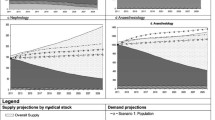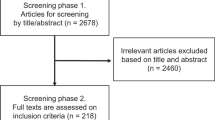Abstract
We propose a stochastic model and provide an easy-to-implement optimization tool for admission decisions to specialized training programmes designed for service industries. The model can be applied for staffing of trainees in medical residency programmes, vocational schools, management trainee programmes, and similar. Especially towards graduation, trainees in these programmes substantially contribute to workforce of their affiliated institutions, thus having a targeted number of advanced level students become a potential performance metric for administration. For uncertain attrition rates and study duration, we model and provide an iterative solution algorithm to find the optimal annual admission number for these programmes. Our numeric analysis results show that the solution is robust to changes in attrition and study duration probabilities; hence, our model is robust against specification errors for these parameters, which could be hard to estimate due to data unavailability and fluctuations in educational and economic conditions.




Similar content being viewed by others
References
Aydın N, Birbil Şİ, Frenk JBG and Noyan N (2012). Single-leg airline revenue management with overbooking. Working Paper, Sabancı University.
Bartholomew DJ (1971). The statistical approach to manpower planning. Journal of the Royal Statistical Society. Series D (The Statistician) 20 (1): 3–26.
Chattopadhyay AK and Gupta A (2007). A stochastic manpower planning model under varying class sizes. Annals of Operations Research 155 (1): 41–49.
de Vries EN, Ramrattan MA, Smorenburg SM, Gouma DJ and Boermeester MA (2008). The incidence and nature of in-hospital adverse events: A systematic review. Quality and Safety in Health Care 17 (3): 216–223.
Deen G and Buni GG (2004). Development of a steady state model for forecasting US Navy Nurse Corps personnel. Master Thesis, Naval Postgraduate School, Monterey, CA.
Dill WR, Gaver DP and Weber WL (1966). Models and modelling for manpower planning. Management Science 13 (4): 142–167.
Dodson TF and Webb ALB (2005). Why do residents leave general surgery? The hidden problem in today’s programs. Current Surgery 62 (1): 128–131.
Feuer MJ and Schinnar AP (1984). Sensitivity analysis of promotion opportunities in graded organizations. The Journal of the Operational Research Society 35 (10): 915–922.
Hershey JC, Abernathy WJ and Baloff N (1974). Comparison of nurse allocation policies—A Monte Carlo model. Decision Sciences 5 (1): 58–72.
Hopkins DSP (1980). Models for affirmative action planning and evaluation. Management Science 26 (10): 994–1006.
Hu W, Lavieri MS, Toriello A and Liu X (2013). Strategic health workforce planning, http://www2.isye.gatech.edu/~atoriello3/hc_wf_plan.pdf, accessed 11 May 2013.
Kinstler DP, Johnson RW, Richter A and Kocher K (2008). Navy Nurse Corps manpower management model. Journal of Health, Organisation and Management 22 (6): 614–626.
Lavieri MS and Puterman ML (2009). Optimizing nursing human resource planning in British Columbia. Health Care Management Science 12 (2): 119–128.
Longo WE, Seashore J, Duffy A and Udelsman R (2009). Attrition of categoric general surgery residents: Results of a 20 year audit. The American Journal of Surgery 197 (6): 774–778.
Martel A and Price W (1981). Stochastic programming applied to human resource planning. The Journal of the Operational Research Society 32 (3): 187–196.
Michtalik HJ, Yeh H, Pronovost PJ and Brotman DJ (2013). Impact of attending physician workload on patient care: A survey of hospitalists. JAMA Internal Medicine 173 (5): 375–377.
Naylor RA, Reisch JS and Valentine RJ (2008). Factors related to attrition in surgery residency based on application data. Archives of Surgery 143 (7): 647–652.
Nuckols T and Escarce J (2013). Cost implications of ACGME’s 2011 changes to resident duty hours and the training environment. Journal of General Internal Medicine 27 (2): 241–249.
Price WL, Martel A and Lewis KA (1980). A review of mathematical models in human resource planning. Omega 8 (6): 639–645.
Pugno PA (2011). Residency attrition: Trends and themes, https://www.aamc.org/download/185478/data/2011_pwc_pugno.pdf, accessed 1 August 2013.
Purkiss C (1981). Corporate manpower planning: A review of models. European Journal of Operational Research 8 (4): 315–323.
Rao PP (1990). A dynamic programming approach to determine optimal manpower recruitment policies. The Journal of the Operational Research Society 41 (10): 983–988.
Ruhnke G W (1996). Residencies and employment under managed care: A medical student’s view. Health Affairs 15 (1): 113–117.
Smith-Daniels VL, Schweikhart SB and Smith-Daniels DE (1988). Capacity management in health-care services: Review and future research directions. Decision Sciences 19 (4): 889–919.
Stanford School of Medicine (2013). Stanford anesthesia residents, http://med.stanford.edu/anesthesia/people/residents.html, accessed 1 August 2013.
Talay-Değirmenci I, Holmes CJ, Kuo PC and Jennings OB (2013). An analytic decision support tool for resident allocation. Journal of Surgical Education 70 (1): 31–35.
Thomas EJ et al (2000). A comparison of iatrogenic injury studies in Australia and the USA I: Context, methods, casemix, population, patient and hospital characteristics. International Journal for Quality in Health Care 12 (5): 371–378.
University of Michigan (2011). Clinical training, http://www.med.umich.edu/oto/edu/clinicaltraining.shtml, accessed 23 September 2012.
University of Rochester Medical Center (2013). Training programs. http://www.urmc.rochester.edu/education/graduate-medical-education/prospective-residents/training-programs.cfm, accessed 1 August 2013.
van Zanten M, Boulet JR, McKinley D and Whelan GP (2002). Attrition rates of residents in postgraduate training programs. Teaching and Learning in Medicine: An International Journal 14 (3): 175–177.
Vogel V (2006). Determining personnel accession requirements for medical service corps health care administrators using a steady-state analysis. MBA Thesis, Naval Postgraduate School, Monterey, CA.
Wagner HM (1995). Global sensitivity analysis. Operations Research 43 (6): 948–969.
Werker GR (2012). Strategic resource planning in healthcare under uncertainty. PhD Thesis, The University of British Columbia, Vancouver, Canada.
Yankovic N and Green LV (2011). Identifying good nursing levels: A queuing approach. Operations Research 59 (4): 942–955.
Ybarra M (2013). The NRMP. http://www.hyperink.com/The-Nrmp-b83a233, accessed 10 August 2013.
Yüceer Ü (2002). Discrete convexity: Convexity for functions defined on discrete spaces. Discrete Applied Mathematics 119 (3): 297–304.
Zhu X and Sherali HD (2009). Two-stage workforce planning under demand fluctuations and uncertainty. Journal of the Operational Research Society 60 (1): 94–103.
Author information
Authors and Affiliations
Additional information
†Işılay Talay-Değirmenci and Öznur Özdemir-Akyıldırım contributed equally to this work.
Appendix
Appendix
Proof of Theorem 1:
-
First we show that there is a unique solution to the admission decision model (AM) by using the convexity of the objective function. The objective function is a discrete function. A univariate function is discrete convex if it has non-decreasing first forward differences (please see Yüceer, 2002 and the references therein).
The objective function in (1) can be written as: 𝔼[f(B(p1, X)+B(p2, Y))] where f:ℤ*↦ℝ is defined as f(k)=c1max(k−N, 0)+c2max(N−k, 0). Noting the similarity of f(k) with the absolute value function
 , we can conclude that f(k) has non-decreasing first forward differences and is discrete convex. Given that, we now show the convexity of our objective function in (1) using Lemma 1. A similar lemma for a different function and a single binomial random variable can be found in Aydın et al (2012, p 23). □
, we can conclude that f(k) has non-decreasing first forward differences and is discrete convex. Given that, we now show the convexity of our objective function in (1) using Lemma 1. A similar lemma for a different function and a single binomial random variable can be found in Aydın et al (2012, p 23). □
Lemma 1
-
If the function f:ℤ*↦ℝ is discrete convex, then the function Y↦𝔼[f(B(p1, X)+B(p2, Y))] is also discrete convex.
Proof of Lemma 1:
-
From hereon when mathematically more suitable, we represent binomial random variables with distribution-wise equivalent Bernouilli selection type random variables. Thus, here we use

where U k , k∈ℕ, is a sequence of i.i.d uniform random variables also independent of X; and we define B(p2, Y) for any Y∈ℤ* similarly. We have (from independence of the random variables)



Hence, for every possible value of B(p1, X)+B(p2, Y), the first forward difference of f function at that value will be multiplied with corresponding probabilities. Similarly we get


Comparing (A.4) with (A.6), and from discrete convexity of f, we get that 𝔼[f(B(p1, X)+B(p2, Y))] has non-decreasing first forward differences. Thus, it is discrete convex.
Given the convexity of the objective function, we can conclude that (AM) has a unique solution and this solution can be found via checking the first forward differences. From (A.4), we have





which gives the formula of the first forward difference in (A.2). The solution space is non-negative integers and when the incrementation starts from (max(0, N−X)), the solution is reached at the smallest Y value with which incrementing by 1 gives a positive first forward difference for the objective function in (1). □
About Remark 1
Note that Median(B(p, X+Y)) is either ⌈(X+Y)p⌉ or ⌊(X+Y)p⌋ and it can be greater than or equal to N−1. This gives a total of four cases. The inequality ((N−2)/(p))−X<Y comes from the case N−1=Median (B(p, X+Y))=⌈(X+Y)p⌉. This case gives N−2<(X+Y)p⩽N−1 and hence a lower bound of ((N−2)/p)−X for Y. When compared with the bounds obtained from the other three cases in a similar way, it can be seen that it is the smallest lower bound for Y provided by these four cases. To ascertain that the algorithm does not miss the optimal value, the lowest lower bound provided by the four cases mentioned here should be taken as the starting point.
Rights and permissions
About this article
Cite this article
Özdemir-Akyıldırım, Ö., Talay-Değirmenci, I. Optimal staffing of specialized programme trainees under uncertainty. J Oper Res Soc 66, 66–75 (2015). https://doi.org/10.1057/jors.2013.167
Received:
Accepted:
Published:
Issue Date:
DOI: https://doi.org/10.1057/jors.2013.167





 , we can conclude that f(k) has non-decreasing first forward differences and is discrete convex. Given that, we now show the convexity of our objective function in (1) using Lemma 1. A similar lemma for a different function and a single binomial random variable can be found in
, we can conclude that f(k) has non-decreasing first forward differences and is discrete convex. Given that, we now show the convexity of our objective function in (1) using Lemma 1. A similar lemma for a different function and a single binomial random variable can be found in 









